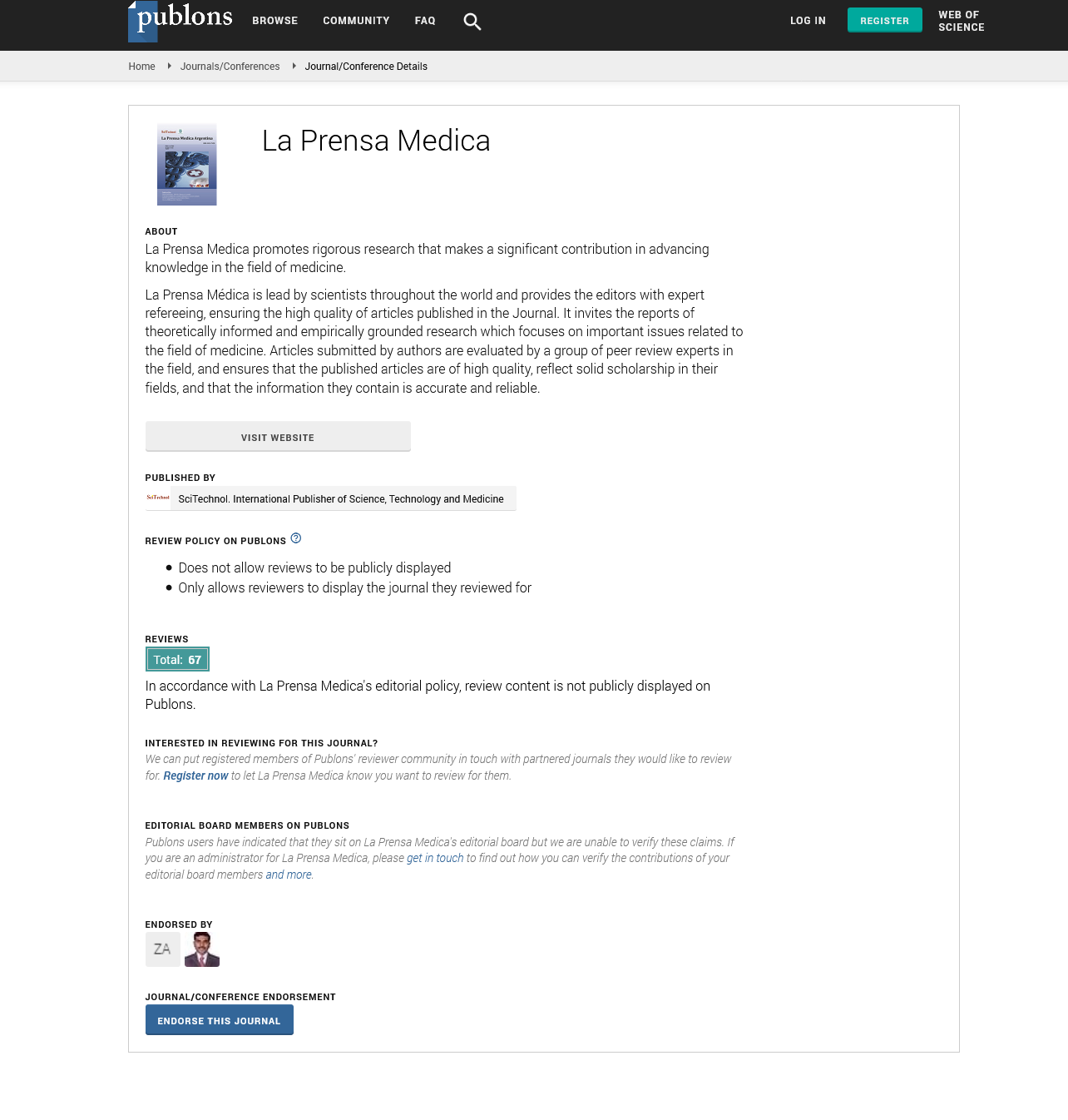Opinion Article, La Prensa Medica Vol: 109 Issue: 3
Navigating the Future of Surgery: From Robotics to Natural Orifice Transluminal Endoscopic Surgery
Brigo Reimer*
Department of Anesthesiology and Intensive Care Medicine, University Hospital Innsbruck, Innsbruck, Austria
*Corresponding Author: Brigo Reimer
Department of Anesthesiology and Intensive Care Medicine, University Hospital
Innsbruck, Innsbruck, Austria
E-mail: reimer29@tirol-kliniken.at
Received date: 29 May, 2023, Manuscript No. LPMA-23-107119;
Editor assigned date: 31 May, 2023, PreQC No. LPMA-23-107119(PQ);
Reviewed date: 15 June, 2023, QC No. LPMA-23-107119;
Revised date: 22 June, 2023, Manuscript No. LPMA-23-107119(R);
Published date: 29 June, 2023, DOI: 10.4172/0032-745X.1000171
Citation: Reimer B (2023) Navigating the Future of Surgery: From Robotics to Natural Orifice Transluminal Endoscopic Surgery. La Prensa Medica 109:3.
Abstract
Description
Surgical innovation and technology have significantly transformed the field of surgery, enabling advancements in techniques, devices, and approaches. From novel surgical procedures to the development of advanced tools and instruments, the landscape of surgical practice continues to evolve. This article delves into the realm of surgical innovation and technology, focusing on cutting-edge techniques and devices that are revolutionizing surgical practice. It explores the potential impact of these innovations on surgical outcomes, patient recovery, and healthcare delivery.
Single-incision surgery
Single-incision surgery has gained significant attention as a minimally invasive technique that offers several advantages over traditional open or multi-port laparoscopic surgeries. By utilizing a single small incision, typically through the navel, surgeons can reduce the potential for scarring and postoperative pain while improving cosmetic outcomes. The use of specialized instruments, such as flexible endoscopes and articulating instruments, allows surgeons to perform complex procedures with precision. Advancements in single-incision surgery have expanded its applications across various surgical specialties. In urology, single-incision surgery has been employed for procedures like nephrectomy, prostatectomy, and pyeloplasty. In gynecology, it has been used for hysterectomy, ovarian cystectomy, and myomectomy. Additionally, single-incision surgery has been explored in gastrointestinal surgery, including cholecystectomy and appendectomy. Despite the potential benefits, challenges still exist in the widespread adoption of single-incision surgery. The technical complexity of accessing and manipulating instruments through a single incision can be demanding for surgeons. Instrument clashing and reduced range of motion may also pose challenges during the procedure. Ongoing research aims to refine the techniques, develop innovative instrumentation, and assess long-term outcomes to establish the safety, efficacy, and broader applicability of single-incision surgery.
Natural orifice transluminal endoscopic surgery
Natural Orifice Transluminal Endoscopic Surgery (NOTES represents an innovative approach to minimally invasive surgery. It involves accessing the surgical site through natural body orifices, such as the mouth, anus, or vagina, thus eliminating external incisions. The procedure utilizes specialized flexible endoscopes and instruments to navigate through the body's internal pathways. NOTES offers several potential advantages, including reduced postoperative pain, decreased risk of surgical site infections, and improved cosmesis. The absence of external incisions minimizes the risk of wound-related complications and enables faster recovery. However, NOTES is still in the early stages of development and faces challenges that hinder its widespread clinical application. One significant challenge is the lack of adequate instrumentation for NOTES procedures. The development of specialized flexible instruments with sufficient maneuverability and stability is necessary to overcome the limitations associated with accessing and manipulating tissues through natural orifices. Additionally, safety concerns related to potential complications, such as organ injury or infection, must be addressed through meticulous patient selection, advanced training, and adherence to established safety protocols.
Image-guided surgery
Image-guided surgery, also known as navigation or computer-assisted surgery, merges the precision of surgical intervention with real-time imaging technology. This technique involves the integration of preoperative imaging, such as computed tomography scans or magnetic resonance imaging, with intraoperative visualization. By overlaying preoperative images onto the surgical field, image-guided surgery provides surgeons with real-time guidance and feedback during the procedure. This technology allows for precise tumor localization, accurate implant placement, and improved visualization of complex structures. Image-guided surgery has been particularly valuable in neurosurgery, orthopedic surgery, and otolaryngology. The advancements in image-guided surgery have been made possible by improved imaging modalities, including high-resolution imaging and three-dimensional reconstructions. Furthermore, the development of specialized tracking systems and surgical navigation software has enhanced the accuracy and reliability of image-guided procedures.
Surgical robotics
Surgical robotics has revolutionized the field of surgery by offering enhanced precision, dexterity, and visualization to surgeons. The da Vinci Surgical System, one of the most well-known robotic platforms, enables surgeons to perform complex procedures through minimally invasive techniques. Robotic-assisted surgery involves the use of robotic arms controlled by the surgeon, which hold and manipulate specialized instruments during the procedure. The system provides a three-dimensional high-definition visualization of the operative field, allowing surgeons to navigate with exceptional precision. Robotic-assisted surgery has been successfully applied in various surgical specialties, including urology, gynecology, cardiothoracic surgery, and general surgery. The benefits of surgical robotics include reduced blood loss, shorter hospital stays, and faster recovery times for patients. The improved visualization and instrument maneuverability offered by robotic systems contribute to improved surgical outcomes. Ongoing research aims to refine robotic platforms, develop novel applications, and assess the long-term efficacy, cost-effectiveness, and safety of robotic-assisted surgery.
Conclusion
Single-incision surgery, natural orifice transluminal endoscopic surgery, image-guided surgery, and surgical robotics represent exciting advancements in surgical techniques and technology. These innovations offer the potential for reduced invasiveness, improved cosmetic outcomes, enhanced precision, and better patient outcomes. While challenges and further research are necessary to optimize these techniques and devices, they hold possibilities for the future of surgical practice.
 Spanish
Spanish  Chinese
Chinese  Russian
Russian  German
German  French
French  Japanese
Japanese  Portuguese
Portuguese  Hindi
Hindi 

